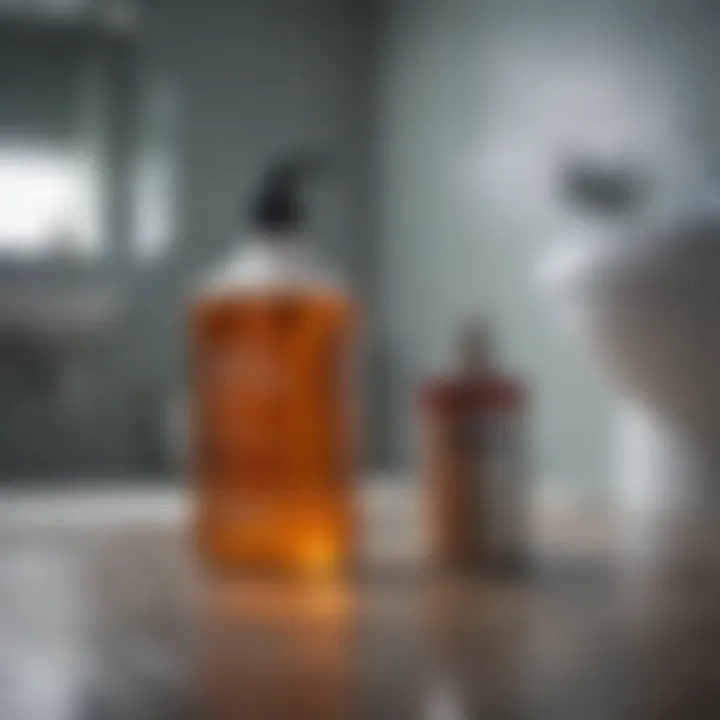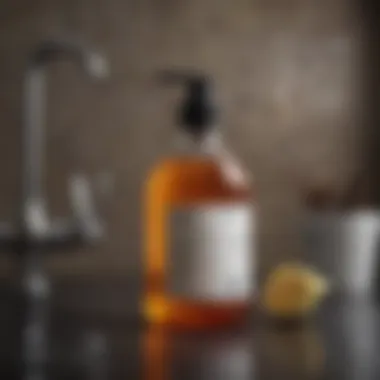Exploring Liquid Plumber for Toilet Clogs: Efficacy & Safety


Intro
In recent times, toilet clogs have become a common household issue. Addressing this problem efficiently is crucial for maintaining home functionality. Among various solutions, Liquid Plumber is often considered as one of the go-to options. This article aims to delve into the use of Liquid Plumber specifically for unclogging toilets.
Liquid Plumber is designed to tackle stubborn clogs with its potent formula. However, while convenience is a key benefit, it does come with potential risks and the need for proper understanding of its contents. Many homeowners are unaware of how it works, why it may be used in toilets, and whether it poses any dangers to plumbing systems.
Overview of Liquid Plumber
Before diving into specifics, it’s important to understand what Liquid Plumber is made of. Liquid Plumber typically contains sodium hydroxide, sodium hypochlorite and other chemical ingredients that contribute to its effectiveness. These components help to break down and dissolve various materials that may lead to clogs.
However, these potent chemicals can also cause harm if not used correctly. The potential for damaging plumbing systems or affecting the environment makes it essential to weigh the benefits and risks involved. In light of this, alternative methods for unclogging toilets will be explored as well.
Overall, this guide seeks to provide clarity on how to use Liquid Plumber for toilet clogs effectively while examining safety implications, and discussing alternative unclogging solutions.
By doing so, readers will find valuable information to help them make informed decisions when confronted with a clogged toilet.
"Being informed is the first step to making safe and effective household decisions, particularly regarding chemical products."
In the sections that follow, we will analyze the effectiveness of Liquid Plumber in unclogging toilets, identifying its advantages and disadvantages, and ultimately, presenting alternatives.
Understanding Toilet Clogs
Toilet clogs present a common household issue that can disrupt daily routines. Understanding the nature and causes of these clogs is vital for homeowners and individuals dealing with plumbing problems. Recognizing the intricacies of this issue can greatly influence the choice of methods for unclogging and restoration of normal function in toilets. The significance of the topic lies in its practical implications. Being well-informed can save time, prevent costly damage to plumbing systems, and offer peace of mind.
Common Causes of Toilet Clogs
Toilet clogs can stem from various factors. Some of the most frequent contributors include:
- Excessive Toilet Paper Use: Overusing toilet paper leads to blockages. The paper can create bulk that water cannot easily dissolve.
- Foreign Objects: Items such as toys, sanitary products, or other non-flushable materials find their way into toilets, resulting in significant blockages.
- Low-Flow Toilets: Many modern toilets conserve water, but this can sometimes mean inadequate flushing. Inadequate water flow may not effectively clear waste from the bowl.
- Build-Up of Minerals: In areas with hard water, mineral deposits can accumulate over time within pipes, narrowing the passage and leading to clogs.
Understanding these causes is the first step in preventing clogs. Homeowners can adopt preventive measures such as educating family members about what can and cannot be flushed down the toilet.
Identifying Symptoms of a Clogged Toilet
Detecting the symptoms of a clogged toilet is essential for timely resolution. Common indicators include:
- Slow Drainage: Water takes longer than usual to drain, often leaving standing water in the bowl.
- Gurgling Sounds: Unusual sounds, usually a sign of air trapped in pipes, may indicate a blockage further down.
- Water Overflow: When flushing leads to water rising dangerously high, it often signals a significant clog.
- Unpleasant Odors: Persistent odors can emerge from a clogged toilet, as waste materials cannot effectively flow and may start to decompose.
Prominent symptoms help homeowners gauge the severity of the issue. Fast identification allows for quicker intervention, possibly avoiding the need for extensive plumbing work.
"Effective management of toilet clogs ensures smooth operation while minimizing the risk of damage to plumbing fixtures."
Educating oneself about clogs and their implications sets the stage for informed decisions. Knowledge of common causes and identifiable symptoms is just the beginning. This foundation can influence further choices in methods applied for unclogging, such as considering products like Liquid Plumber and weighing their effectiveness.
Liquid Plumber: An Overview


Understanding Liquid Plumber is essential for homeowners dealing with frequent toilet clogs. This section sheds light on its components and applications. Liquid Plumber is widely recognized as a drain cleaner and is used in various household settings. It is important to grasp the benefits as well as the potential drawbacks of this product to ensure safe usage and effectiveness.
Liquid Plumber works primarily through its chemical makeup. The specific ingredients dictate how effectively it interacts with different types of clogs. It is crucial to understand these elements before applying it to your plumbing system. Knowing the composition can help in making an informed decision.
Additionally, the intended uses of Liquid Plumber are often misunderstood. Many people may assume it can resolve any type of blockage in toilets. In reality, its designed purpose and effectiveness may vary between different drain types. Understanding these intended uses can guide homeowners in selecting the right approach to their plumbing issues.
Though marketed as a reliable solution, users should consider the implications of using Liquid Plumber. Its interaction with various plumbing materials might pose risks. This knowledge is vital, especially if one hopes to maintain their plumbing systems' integrity over time.
Composition of Liquid Plumber
The composition of Liquid Plumber is critical to its function as a drain cleaner. Most formulations contain powerful chemicals like sodium hydroxide, which acts as a highly effective agent in breaking down blockages. This particular ingredient is known for its caustic properties, allowing it to dissolve organic materials such as hair, grease, and soap residue.
Other forms of Liquid Plumber may include a combination of surfactants. These help to lower the surface tension of water, enhancing its ability to penetrate clogs. The formulations can differ markedly across different product lines, making it essential to read labels carefully.
Environmental considerations also arise here. While these chemicals can clear pipes, they can have negative implications for septic systems and local ecosystems. Therefore, understanding the complete makeup of the product is vital before application.
Intended Uses of Liquid Plumber
Liquid Plumber is primarily intended for clearing clogged drains and sinks, not specifically toilets. Many consumers might mistakenly believe it can universally address all types of clogs. However, its intended use focuses on minor clogs rather than complete blockages that often occur in toilet systems.
One common use is in bathroom sinks and kitchen drains where typical materials cause blockages. That said, it is not advisable to use Liquid Plumber in a toilet due to the significant risk of damage to the internal components.
Here are some of the typical uses:
- Clearing hair blockages in sink drains.
- Dissolving soap buildup in shower and bath drains.
- Addressing grease and food particulate in kitchen sinks.
Homeowners should closely follow product guidelines to maximize effectiveness while minimizing risks associated with misuse. Using chemicals designed for different plumbing systems can lead to complications and ultimately higher repair costs. Being clear about the intended uses can save time and money in the long run.
Can Use Liquid Plumber in My Toilet?
Understanding whether one can use Liquid Plumber in a toilet is crucial for homeowners dealing with clogs. While Liquid Plumber is widely recognized as an effective drain cleaner, doubts often arise regarding its compatibility with toilet systems. This section aims to clarify the specific elements to consider when thinking about using this chemical solution, its potential benefits, and the critical considerations that accompany its use.
Using Liquid Plumber in your toilet can seem like a tempting solution, especially for stubborn clogs. However, it is essential to grasp what this product contains and how it interacts with toilet plumbing. Primarily, knowledge of your plumbing system will help in making informed decisions. Many toilets have a delicate balance of parts, and introducing potent chemicals could disrupt this balance, creating further complications.
Moreover, potential benefits of Liquid Plumber include its fast-acting formula, which can dissolve hair, soap scum, and other organic materials that often cause blockages. However, weighing these benefits against the risks is necessary.
Assessing Compatibility with Toilet Systems
Not all plumbing systems are equal, and compatibility of Liquid Plumber with your specific toilet system is paramount. Toilets are made with various materials ranging from porcelain to plastic components, each reacting differently to harsh chemicals. Liquid Plumber is primarily a strong caustic agent, featuring sodium hydroxide that can break down clogs but may also corrode certain materials.
Homeowners should do a thorough inspection of their toilet system, focusing on the following:
- Material Composition: Identify the materials used in the toilet components, especially the seals and gaskets.
- Maintenance History: Assess previous repairs or changes made to your plumbing. Components that have been repaired may not withstand chemical exposure.
- Age of Toilet: Older toilets may have outdated materials that could react adversely to Liquid Plumber.
Being aware of these factors will help prevent any unwanted damage during clog treatment.


Manufacturer's Guidelines and Recommendations
Follow the manufacturer's guidelines for the use of Liquid Plumber carefully. Each product generally comes with specific instructions. Reading and understanding these instructions is integral. Here are some important points to be mindful of:
- Dosage: Always use the recommended dose to avoid excessive buildup of chemicals in the plumbing system.
- Timing: Liquid Plumber products often require a certain amount of rest time to take effect. Allowing it to sit too long may cause more harm than good.
- Avoid Mixing Chemicals: Do not mix Liquid Plumber with other chemical agents, as this can create dangerous reactions.
- Ventilation: Ensure the area is well-ventilated when applying the product, as chemical fumes can be harmful.
By following these guidelines, users can maximize effectiveness while minimizing risks when considering Liquid Plumber for toilet clogs.
Potential Risks of Using Liquid Plumber
Using Liquid Plumber for toilet clogs may seem like a straightforward solution, but it carries several potential risks that homeowners should seriously consider. Understanding these risks is vital for anyone contemplating the use of chemical drain cleaners. While there is a promise of a quick fix for stubborn clogs, the safety and longevity of plumbing systems should not be overlooked. This section will explore the dangers associated with chemical reactions and the effects on components like seals and gaskets. Being informed can help prevent irreversible damage and costly repairs, ensuring that home plumbing remains in good condition.
Chemical Reactions Within Plumbing Systems
Liquid Plumber contains harsh chemicals designed to dissolve clogs quickly; typically, sodium hydroxide, bleach, or sulfuric acid. When poured into a toilet, these substances can create dangerous chemical reactions, especially when combined with other household cleaners. For example, if Liquid Plumber is used after a previous cleaner that contains acid, the mixing can generate toxic fumes, posing health risks to anyone nearby. High levels of heat can also form during these reactions, potentially causing pipe damage and creating hazardous situations.
- Safety Precautions: Always read the label before using any chemical cleaner.
- Avoid Mixing: Never mix different brands or types of chemical cleaners.
- Ventilation: Ensure adequate ventilation to minimize inhalation of toxic fumes.
Homeowners must recognize that while these chemicals effectively clear blockages, they may introduce new problems. Repeated use can corrode pipes, especially older metal ones, making them more susceptible to leaks and fractures over time.
Impact on Toilet Components and Seals
Toilets are comprised of multiple components, each playing a specific role in efficient operation. Liquid Plumber’s chemical composition can weaken rubber parts like flappers and seals, leading to leaks and inefficiencies. Prolonged exposure to harsh chemicals may cause these components to deteriorate faster than normal, resulting in expensive repairs or replacements.
- Key Components Affected:
- Flappers: These control water flow within the toilet and can degrade, causing constant running.
- Seals: Rubber seals ensure a watertight connection between tank and bowl. Damage to these can cause leaks.
"Using harsh chemicals can lead to a cascade of plumbing issues, rather than a single, resolved clog."
Most manufacturers do not recommend the use of chemical drain cleaners for toilets, given the potential for damage. Therefore, while Liquid Plumber might be effective for clearing clogs, it can become a double-edged sword that increases repair costs in the future. Taking these risks into account can guide homeowners toward safer, more effective methodologies for unclogging toilets.
Alternative Methods for Unclogging Toilets
Toilet clogs can be a frequent nuisance in any household. While Liquid Plumber offers a chemical solution, it is crucial to explore alternative methods for unclogging toilets. These methods may be safer, more environmentally friendly, and equally effective. Understanding various techniques not only broadens your toolkit for dealing with plumbing issues but also helps avoid potential damage that chemicals might cause to toilet systems.
Implementing alternative methods can lead to a quicker resolution of clogs. They often require minimal tools and can be executed without professional help. The benefits of exploring these techniques include preventing recurring clogs and maintaining a healthier plumbing environment. Knowing when to use a mechanical or homemade solution can make a significant difference in your plumbing maintenance strategy.
Plunging Techniques
Plunging is one of the most effective and commonly used techniques for clearing toilet clogs. It is straightforward and doesn't require any chemical intervention. A toilet plunger is designed specifically to create a vacuum effect in the bowl, effectively dislodging the blockage. Here are some important considerations for successful plunging:
- Use the right type of plunger: Ensure you have a flange or bell-shaped plunger, which provides a better seal in toilet bowls.
- Positioning: Submerge the plunger's cup in the water, covering the drain completely. This helps in maximizing pressure.
- Technique: Plunge with steady, forceful movements. Push down and pull up, but avoid lifting the plunger out of the water, as this may break the seal.
- Repeat as necessary: It may take several tries to clear the blockage. Consistency is key.
Plunging is often the first line of defense and can clear common clogs caused by waste or toilet paper.


Using a Toilet Auger
If plunging does not solve the clog, using a toilet auger is a next step. A toilet auger is a specialized tool designed to reach deeper obstructions beyond what a plunger can clear. It consists of a long, flexible cable and a coiled end to grab or break apart clogs.
Here’s how to use a toilet auger effectively:
- Insert the auger: Carefully feed the auger into the toilet bowl.
- Push gently: Rotate the handle while gently pushing the cable deeper into the drain until you feel resistance, signaling a clog.
- Break apart the blockage: Once you hit the clog, continue rotating the handle to break or snag the obstruction. This may take several moments.
- Retrieve the auger: Withdraw the auger slowly while turning it to prevent any mess. Flush the toilet afterward to clear any remaining debris.
A toilet auger can navigate bends in the plumbing system, which makes it more effective for tougher clogs.
Homemade Solutions for Clogs
Homemade solutions can be an effective, eco-friendly alternative to chemical treatments like Liquid Plumber. Many homeowners have discovered unconventional but safe methods that utilize common kitchen ingredients. Here are some popular options:
- Baking Soda and Vinegar: Pour one cup of baking soda followed by one cup of vinegar into the toilet. Allow this mixture to sit for at least 30 minutes, then flush. This reaction can help break down organic matter.
- Hot Water: Pouring a bucket of hot (not boiling) water into the bowl can sometimes dissolve clogs caused by toilet paper and waste.
- Salt and Baking Soda: Combine one cup of salt with one cup of baking soda. Let it sit in the bowl for a few hours before flushing. This combination can help create a more abrasive action on the clog.
Professional Help: When to Call a Plumber
When considering solutions for toilet clogs, knowing when to engage a professional can save time and prevent further complications. While some clogs can be managed with household tools or chemical products like Liquid Plumber, others may require the expertise of a trained plumber. Understanding specific indicators that signal the need for professional assistance is essential in maintaining a functional plumbing system.
Indicators for Seeking Professional Assistance
In certain situations, recognizing the signs that indicate when to call a plumber can prevent a minor issue from escalating into a major problem. Here are some key indicators:
- Repeated Clogs: If your toilet continues to clog despite your best efforts, it may suggest a more severe blockage in the plumbing line.
- Multiple Fixtures Affected: If you experience clogs in other areas of your home, such as sinks or showers, this could signal a larger plumbing issue that requires professional intervention.
- Unpleasant Odors: Foul smells emanating from your toilet or drains can indicate a backlog of waste or a sewer line issue.
- Slow Draining: Toilets and drains that are sluggish can suggest a partial blockage that may soon become more serious.
"Experiencing continual plumbing issues can often hint at a deeper problem; professional help may be the best approach."
Cost Considerations for Plumbing Services
Engaging a plumber involves costs that can vary widely depending on the type of service required and your geographical location. Here are several cost considerations to keep in mind:
- Service Call Fee: Many plumbers charge a flat fee for arriving at your property, which usually covers their time and fuel.
- Hourly Rates: Plumbers often charge by the hour. Typical rates can vary from $45 to $200 depending on their experience and the job’s complexity.
- Parts and Materials: If the clog requires parts or materials, such as a new flapper for the toilet or additional plumbing fixtures, these expenses will also add to the total.
- Emergency Services: In urgent scenarios, many plumbers offer emergency services at a premium rate, potentially doubling their hourly fee during off-hours.
Taking into account these elements not only prepares you financially but also helps in making informed decisions on whether to attempt a DIY solution or seek professional help.
Finale
Understanding how to effectively address toilet clogs is essential for any homeowner. This article has examined various aspects of using Liquid Plumber as a potential solution for unclogging toilets. With the growing prevalence of plumbing problems, knowing what products to use, and when to seek professional help can save both time and money.
Summary of Findings
The investigation into Liquid Plumber has shown that while it can be an effective method for dealing with some clogs, its use in toilets is fraught with risks. The chemical composition can cause damage to toilet components, particularly seals and mechanisms. Additionally, specific plumbing systems may react adversely to such products.
In summary, Liquid Plumber may provide immediate results for minor clogs but carries the potential for significant damage and longer-term issues within the plumbing infrastructure of a home. For serious clogs or persistent issues, alternative methods or professional assistance is recommended.
Recommendations for Homeowners
Homeowners should consider the following key points when deciding how to address toilet clogs:
- Assess the Severity of the Clog: Determine whether the issue is a minor obstruction or requires professional assessment.
- Consider Alternative Methods: Evaluate the potential of simple plunging or using a toilet auger before resorting to chemical solutions.
- Follow Manufacturer Instructions: Should Liquid Plumber be chosen as a solution, strictly adhere to the instructions provided to mitigate any risk of damage.
- Seek Professional Help: If clogs are frequent or resistant to standard methods, engage a licensed plumber for an inspection to prevent expensive plumbing repairs later.
By weighing these factors, homeowners can approach the challenge of toilet clogs with confidence, ensuring a secure and efficient plumbing system.















